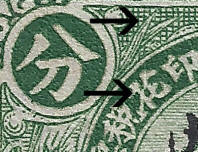 |
|||||||
|
Forerunners Mukden Opium Destroy Certificates Manchukuo Manchukuo Marriage Registration Tax Harbin & Mukden Municipal Revenues Kwantung
|
|||||||
|
Mukden (Moukden) Municipal Issues
|
|||||||
|
Mukden produced a range of Municipal Revenues they were used to raise taxes for the area, in particular a form of purchase tax and are often found on receipts. The Chinese banner above the gate reads (right to left), Republic of China, Mukden, Revenue Stamp. In addition to the stamps shown below, special municipal taxes were also applied to sales of wine, and a special Mukden wine tax stamp also exists. A common feature of these stamps is the building in the central cartouche, there is some dispute, even in China, about which building this is. Most are certain it is the Drum Tower, others think it might be the North Gate. The Drum Tower was built in 1637 and contained a bell and a drum (and later a clock). The original purpose was as a gateway into the walled town, it also acted as a watchtower to warn of fires within the old city and enemies without. The drum was used to impose a curfew - by the last of the 600 beats of the drum the population must be off the streets. The tower was demolished to ease traffic congestion before these stamps were printed. Postcards of the Drum Tower appear regularly and these images leave little doubt in my mind. The pavilions atop the North Gate have two tiers but are broader, and the same is true of the two tier gate to the Northern Tombs. Background To understand these issues it is necessary to know a little about the history of Manchuria at this time, Shenyang, then Mukden was controlled by the "Old" Marshal 張作霖 Zhang Zuolin (Chang Tso-lin). Zhang started out as a bandit and became a powerful warlord leading a substantial army. He had considerable political influence in China becoming the governor of Manchuria. His base was Fengtian province (today Liaoning), the capital of which was Mukden. In 1920 the economy of Fengtian had all but collapsed due to the need to repay foreign debt, it was at this time Zhang appointed the financially astute Wang Yongjiang to oversee the regional tax office, and later appointed appointed him Director of the Bureau of Finance and Civil Governor of Fengtian province. Wang moved the local currency onto the silver standard, this gave the Fengtian dollar a credibility lacked by other currencies available in China, including that of the national government in Peking and gave it parity with the Japanese golden yen. Looking at the stamps below you will see some overprinted 現详Cash Silver and also see references to 1 dollar, all of these refer to the Fengtian dollar backed by silver. In 1926 Wang and Zhang argued because Zhang needed more money for the military and this drain on the treasury started to undermine the economy. Wang resigned and Manchuria suffered a severe recession. In March of 1926 an acting governor a Mr Hui was appointed, to be replaced in October when the new governor Mr Hiu took office, his principle aim was to keep Zhang's army supplied with money so that he could continue to hold territory South of the Great Wall. The new Governor issued bonds that local businesses were compelled to buy and he also created the revenue stamps shown below. Zhang was assassinated as part of a Japanese plot in June 1928 and replaced by his eldest son (by his official wife), the "Young" Marshall Zhang Xueliang. After the Mukden Incident in September 1931 the Japanese established and controlled The Fengtian Maintenance Committee for Local Autonomy, This committee continued to raise taxes and manage the Mukden/Fengtian economy until 1932 and the formation of Manchukuo. Some of the Mukden Municipal revenue stamps were overprinted at this time and used as provisional issues. To see examples of these stamps in use on original documents click here.
|
|||||||
| c1926 (Large) General Mukden Municipal Issue | |||||||
|
c1926
this stamp appears to have been issued to act as a receipt for tax
paid within the Fengtian area. They appear to have been in use for
two years between 1926 and 1928, when they were replaced with a
smaller version. The design features the Drum Tower bordered by wheat stalks. The top banner reads 中華民國奉天印花税票 “Republic of China Mukden Revenue Stamp” (the Chinese text reads from right to left). The stamps are overprinted with four characters in black 印花税處 “Stamp Tax Office. (Wetterling translates this as “Stamp Duty Office”). I doubt that this stamp exists without an overprint. |
|||||||
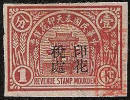
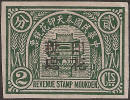 |
|||||||
 |
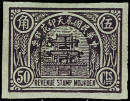 |
$1 | |||||
|
Known Values - 1c Brown or Red Brown, 2c Green, 10c Red, 50c Black, and $1 Blue. Litho Printed, Size 28.75mm x 20mm on thin un-watermarked paper, always imperf. |
|||||||
|
|
|||||||
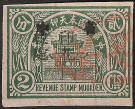 |
|||||||
| Control chops appear to be rare for this issue and the example for 省中 (Shěng zhōng) Province is unlisted. It is not known if this chop appears on the full set. | |||||||
|
|
|||||||

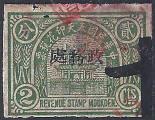 |
|||||||
|
c.1926/7
Wetterling lists the above
three-character machine
overprint "處務政
which he translates as “Government Business Office” in Google
Translate it reads "Administrative Services Department" a
similar meaning.
Examples are rare and it is not known if this
overprint appears on the full set. What is not generally known is that these stamps were issued exclusively in the provinces of Shansi, Chahar and Hopei when this territory was held and controlled by the forces of Marshall Zhang Zoulin. |
|||||||
|
|
|||||||
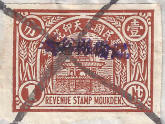 |
|||||||
| c.1926/7 This unlisted overprint in purple is probably a control chop, it is applied over the machine overprint 處務政 shown above. The overprint is far from clear but it probably reads 臨榆縣分局 Lin Yu Sub-Office or 臨榆稅公署 LinYu Tax Office (LinYu is another name for ShanHaiGuan). This example, which is on a rental payment receipt, is possibly unique. | |||||||
|
|
|||||||
| April 1928, (Small) General Mukden Municipal Issue | |||||||
|
April
1928
The design of this stamp is very similar to that
of the first issue; the text is identical both in Chinese and
English, the main difference being the size.
As previously
the design features what may be the Drum Tower
Gate bordered
by wheat stalks. The top banner reads
中華民國奉天印花税票
“Republic of China
Mukden
Revenue Stamp”
(the Chinese text reads from right to left).
First Set - Engraved |
|||||||
 |
 |
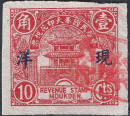 |
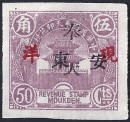 |
$1 Blue |
|||
|
Known Values - 1c Blue, 2c Green and 10c Red Engraved, Size 21mm x 19.5mm on thin un-watermarked paper, always imperf. Engraved Litho For identification of the early 2f look for the straight lines in the background and a break in the character 花 Huā. This appears on both the 1c, 2c and 10c stamp. Note that the background behind the drum tower gate is also shaded from the roofline upwards and this stamp is slightly larger than the following litho printings. In this version only the 10c appears to be overprinted with 現详Cash Silver (in blue). |
|||||||
| Re-Issue of 1c Blue & 2c Green - Litho | |||||||
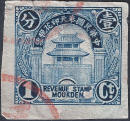
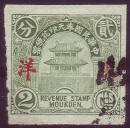 |
|||||||
|
Latest
1928 Litho, Size 20mm x 18mm on thin
un-watermarked paper, always imperf.
It is possible that the 2c stamps appeared a little later than the 1c blue based on the addition of the 現详Cash Silver overprint. I have one example of the 2c green litho on a document and this is dated 1930, but it is known the red chop was used from at latest mid 1929.. Thanks to Brian Denham for the image of the 2c Green. |
|||||||
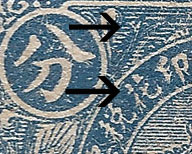
 Original Engraved Re-issue Litho For identification look for the cross hatched lines in the background and no break in the character 花 Huā. This issue is also smaller. |
|||||||
| 1c Brown and 1c Brown Re-touched Litho | |||||||
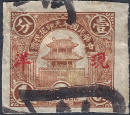
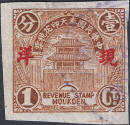 |
|||||||
|
Both issues are always overprinted with
現详Cash
Silver (in red).
Issued before July 1929, with no lines in the sky behind the Drum Tower, re-touched or new plates made mid 1930 with lines added to the sky (see below). These dates can be confirmed by examining documents here. The blue 1c stamp had probably caused some confusion, 1c revenue stamps had always been brown in the past and it is likely that this was the reason for the change. Litho, Size 20mm x 18mm on thin un-watermarked paper, always imperf. Both issues are always overprinted with 現详Cash Silver (in red). |
|||||||
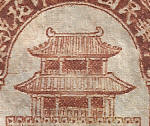
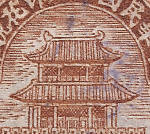 Original Re-touched For identification look for the lack of lines in the sky behind the Drum Tower. |
|||||||
|
|
|||||||
| Control Chops (Most of these are unlisted). | |||||||
| 安東税局 Antung Tax Tax Bureau | 1c | 2c |
 |
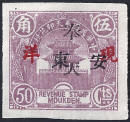 |
|||
| Engraved | Engraved | ||||||
| 長白Chang Bai |
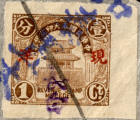 |
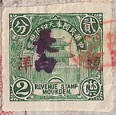 |
10c | ||||
| Litho | |||||||
| 昌圖 "Changtu" (County and Town) on types 1a and 2 |
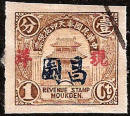 |
2c |
 |
||||
| Litho | Engraved | ||||||
|
錦縣
Chin Hsien (Jin County) |
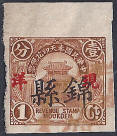 |
2c | 10c | ||||
| Litho | |||||||
| 復縣 Fu Hsien | 1c |
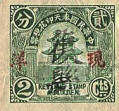 |
10c | ||||
| Litho | |||||||
| 抚顺局 Fushun Bureau |
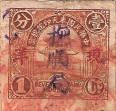 |
2c | 10c | ||||
| Litho Re-touched | |||||||
| 海城税局 Haicheng Tax Bureau |
 |
2c | 10c | ||||
| Litho | |||||||
| 岫岩税局 Hsiu-yen (Xiu yan) Tax Office - on a document dated August 1930 |
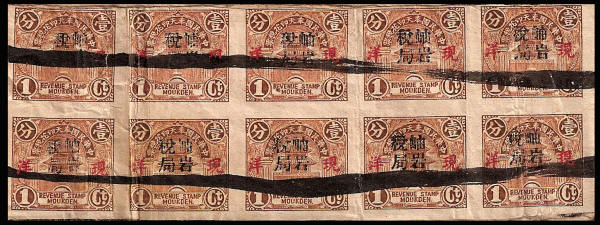 |
||||||
|
Litho |
|||||||
|
義 縣
I-hsien
(Yixian) Large Characters |
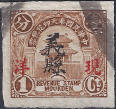 |
2c | 10c | ||||
| Litho Original | |||||||
|
義 縣
I-hsien
(Yixian) Small Characters |
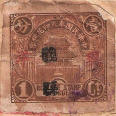 |
2c | 10c | ||||
| Litho Re-touched | |||||||
| 蓋平 "Kai Ping" (County and Town) on types 1a and 2 red-brown |
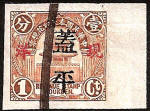 |
2c |
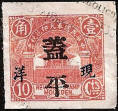 |
||||
| Litho Re-touched | Engraved | ||||||
| 開原 Kai Yuan |
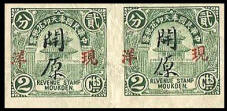 |
||||||
| Litho | |||||||
| 梨樹 LiShu |
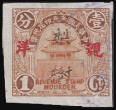 |
2c | 10c | ||||
| Litho | |||||||
| 遼中 "LiaoChung" |
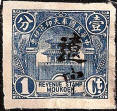 |
 |
2c | 10c | |||
| Engraved | Litho | ||||||
| 營口 "Yingkow" in blue on type 1a. |
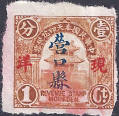 |
2c | 10c | ||||
| Litho Re-touched | |||||||
|
|
|||||||
| Fengtian (Mukden) Cigarette Tax | |||||||
|
c1920.
This is a local cigarette tax paid
stamp, part of a small set that is rarely seen. The characters read
奉天省
Fengtian County and below
證 Certificate 捲菸 Cigarette
稅 Tax. The
design features the Drum Tower typical of the other local revenue
stamps in Mukden. Size 12.6mm x 31mm. Thin White Un-watermarked Paper, Imperf. Lithographed - The printers are unknown. |
|||||||
 |
 |
5c Orange | 10c unknown | 1Y Purple | |||
| The above examples have a control chop which reads 省城 provincial capital.. Other values may exist. | |||||||
|
|
|||||||
|
1931 Third General Fengtian (Mukden) Municipal Issue
September 1931 These stamps had a different heading in the banner 奉天印花税票 "Fengtian Revenue Stamp" with a script Fengtien instead of Revenue Stamp Moukden at the base. After the Japanese Occupation, and before the formation of Manchukuo, there existed a Japanese controlled Fengtian Maintenance Committee for Local Autonomy, it is probably during this period that this stamp was in use. This would explain the dropping of the 中華民國 Republic of China from the banner. This stamp also has the overprint 現详meaning "cash silver" in black. |
|||||||
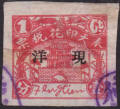 |
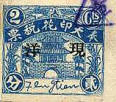 |
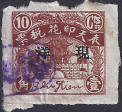 |
|||||
|
Known Values – 1c, Red, 2c Blue, 10c
Red Brown
Litho Printed, Size 22mm x 20mm on thin un-watermarked paper, always imperf |
|||||||
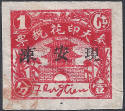 |
2c Blue | 10c Brown | |||||
| Examples with additional control chops for 安東 Andong. Another known control chop is 西安 Xi-an, also in black and due to the alignment it appears that these may have been added after the original overprinting process. | |||||||
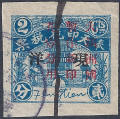 |
|||||||
|
From March 1932 these stamps were overprinted with the characters
花壹分用 Spend
as 1 fen,
暫作新印
Temporary use as new stamp, 大滿州國
Great Manchukuo.
The above is clearly designed municipal use and these stamps were replaced by the countrywide first general issue of revenue stamps for Manchukuo in October of 1932. This seems to have ended this form of local taxation. |
|||||||
|
|
|||||||


